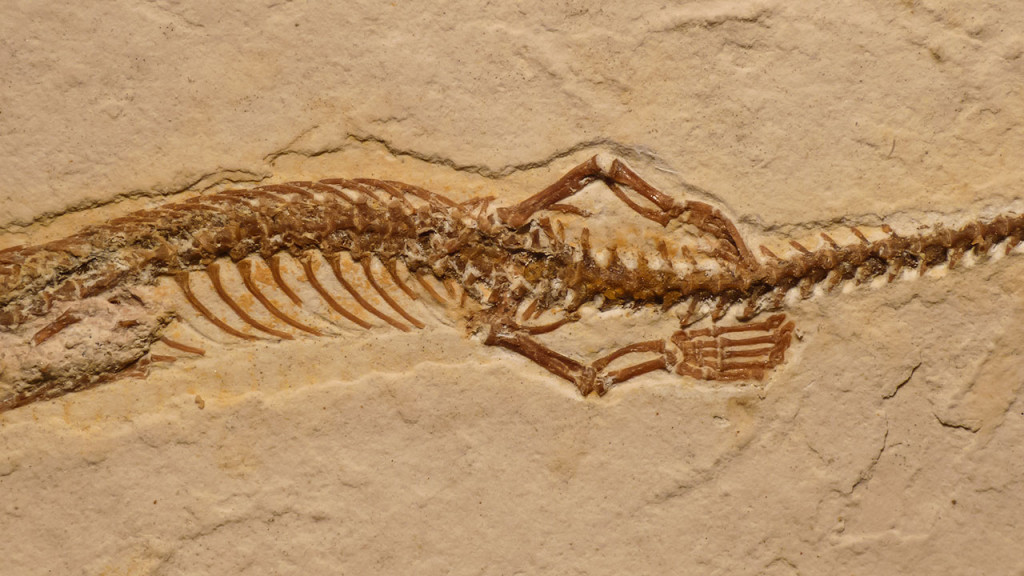Scientists have described what they say is the first known fossil of a four-legged snake. The limbs of the 120-or-so-million-year-old, 20-centimeter-long creature are remarkably well preserved and end with five slender digits that appear to have been functional. Thought to have come from Brazil, the fossil would be one of the earliest snakes found, suggesting that the group evolved from terrestrial precursors in Gondwana, the southern remnant of the supercontinent Pangaea. But although the creature’s overall body plan—and indeed, many of its individual anatomical features—is snakelike, some researchers aren’t so sure that it is a part of the snake family tree.
The team’s scientific interpretation may be the least controversial aspect of the discovery, which they report online today in Science. The specimen’s provenance seems to be murkier than the silty waters that once buried its carcass. Whereas the team’s analyses strongly suggest the fossil came from northeastern Brazil, details of when it was unearthed and how it eventually ended up in the German museum where it now resides remain a mystery. Those details matter to many researchers and especially to some from Brazil, because it’s been illegal to export fossils from that nation since 1942.
Aptly, the new species has been dubbed Tetrapodophis amplectus. The genus name, in Greek, means “four-footed serpent.” (Previously, fossils of creatures considered to be protosnakes have only sported one set of limbs, usually hindlimbs.) The species name amplectus, which comes from Latin, means “embracing” and refers to the creature’s flexibility and presumed ability to wrap tightly around its prey. The front part of the fossil—which appears to be complete and has all bones in their original, lifelike arrangement—lies in a tight coil, a demonstration of the animal’s extreme limberness, says Nicholas Longrich, a vertebrate paleontologist at the University of Bath in the United Kingdom and co-author of the new study. Besides the tiny limbs, the specimen sports a skull the size of a human fingernail, 160 spinal vertebrae, and 112 vertebrae in the tail.

Dave Martill/University of Portsmouth
Tetrapodophis (rear limbs shown), had delicate but functional limbs that may have been used for grasping prey or used during mating.
The fossil had resided in a private collection for several decades before it gained the attention of team member David Martill of the University of Portsmouth. He stumbled across the specimen during a field trip with students to Museum Solnhofen in Germany. No notes about when or where it was collected are available, the researchers say. But certain characteristics of the limestone that entombed the fossil, as well as the distinct orange-brown color of the bones themselves, strongly suggest it came from a particular area of northeastern Brazil, Longrich says. The sediment that became those rocks accumulated in calm waters on the floor of a lake or a lagoon sometime between 113 million and 126 million years ago, he notes.
Regarding the legality of the fossil’s collection or export from its presumed home country, Martill says “Who knows how the fossil came from Brazil”? Furthermore, he notes, to assert that the fossil was collected illegally a person would need to ascertain when it was unearthed. But such questions are irrelevant to the fossil’s scientific significance, Martill maintains. “Personally I don’t care a damn how the fossil came from Brazil or when,” he says.
Many features of Tetrapodophis point to its snakiness. Among squamates, the group of reptiles that also includes lizards, only snakes have more than 150 spinal vertebrae, the researchers note. The creature’s teeth are pointy and slightly curved. Also, the fossil includes some scales that stretch across the full width of the belly, a trait known only in snakes. The dramatically reduced size of the creature’s limbs, as well as a cylindrical rather than a flattened tail, suggest that snakes evolved from terrestrial animals that burrowed, not from marine creatures as some researchers have proposed, Longrich says.



 July 24th, 2015
July 24th, 2015  Riffin
Riffin 
 Posted in
Posted in  Tags:
Tags: 